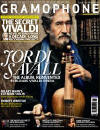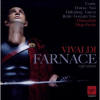Texte paru dans: / Appeared in:
*

GRAMOPHONE (11/2011)
Pour s'abonner /
Subscription information
Virgin 0709142

Code-barres / Barcode:
5099907091421
Consultez toutes les évaluations recensées pour ce cd
~~~~ Reach all the evaluations located for this CD
Reviewer: David
Vickers
This Ferrara version of Farnace -
includes a reconstructed Act 3
Lucchini’s libretto Farnace was first set to music for
Rome in 1724 by Vinci but over the next 14 years Vivaldi composed, performed
or at least attempted six different versions of it (and may have also been
involved with a pasticcio version at Florence in 1725). His original setting
was premiered during the 1727 Venice Carnival but the music only survives in
two manuscripts that respectively contain his different revised versions for
Pavia (1731) and Ferrara (1738). The Ferrara production was cursed by
misfortune and intrigues, partly because the Papal governor of Ferrara
disapproved of the Red Priest’s notorious disinclination to perform
ecclesiastical duties and the allegations surrounding his relationship with
his ‘nurse’ Anna Girò;
the venture was cancelled and Vivaldi retreated to Venice, probably
abandoning work on the extensively rewritten score (the 1738 manuscript
contains only Acts 1 and 2; no libretto was ever printed).
This complicated history is written about with incomparable elegance by Frédéric Delaméa, who has also collaborated with Diego Fasolis in preparing a performing edition of the Ferrara version, including a diligently ‘reconstructed’ Act 3.
Fasolis’s performance is more convincing than Jordi Savall’s erratic 2001 live recording of the Pavia version (reissued two years ago as part of Naïve’s Vivaldi Edition).
I Barocchisti’s playing flows freely between energy and eloquence, and Fasolis ensures a perfect match of stylishness and imagination in the diverse aria accompaniments (even if the use of a choir instead of soloists for the few choruses seems anachronistic). Max Emanuel Cencic is on fine form as the king of Pontus, under attack from the Roman army of Pompey; the countertenor’s brilliant coloratura is never merely showy, his poetic lament singing is superb (‘Perdono, o figlio amato’), and his knack for portraying explosive vengefulness does not preclude intelligent musicality (‘Gemo in un punto e fremo’). Selinda’s ‘Al vezzeggiar d’un volto’ is beautifully hushed by Ann Hallenberg (Vivaldi cut this from the Ferrara version but Delaméa and Fasolis wisely restore it). Karina Gauvin flawlessly emulates a virtuoso nightingale (‘Quell’usignolo che innamorato’) and gorgeously conveys a murmuring breeze (‘Scherza l’aura lusinghiera’). Mary Ellen Nesi relishes the stormy implacability of Berenice (Farnace’s mother-in-law from hell who has joined the Romans); the conflict with her defiant daughter Tamiri and the noble Pompeo reaches a magnificent climax in two fantastic arias at the end of Act 1: Tamiri’s heroic trumpet aria ‘Or di Roma forti eroi’ is sung with plenty of spark by Romanian mezzo-soprano Ruxandra Dônose, and Pompeo’s valorous soliloquy ‘Non trema senza stella’ has two concertante oboes juxtaposed with turbulent strings. Aquilio’s bold ‘Alle minacce di fiera belva’ (featuring a thrilling pair of horns) is sung with an admirable balance of brawn and polish by Emiliano Gonzalez Toro.
The plot and characterisations sizzle while
there is irreconcilable conflict, and, even if the ensuing lieto fine is
spectacularly implausible, this marvellous recording reveals that Vivaldi’s
theatrical fantasy is a journey worth taking.
*
Cliquez l'un ou l'autre
bouton pour découvrir bien d'autres critiques de CD
Click either button for many other reviews


